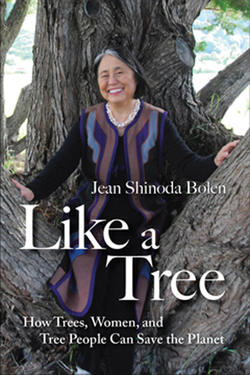Читать книгу Like a Tree - Jean Shinoda Bolen - Страница 16
На сайте Литреса книга снята с продажи.
The Tree Sitter and the Passerby
ОглавлениеOn Vancouver Island, in June 2010, Hilary Huntley, a young Canadian artist, suddenly became a tree activist when she learned that three majestic Garry oaks (Quercus garryana) were to be cut down for a sports field and took immediate personal action. She climbed into one of them, determined to thwart the tree cutters, and became the center of a spontaneous community effort to save them. A day after Hilary climbed into her perch, Clare Peterson was taking a morning walk on a trail nearby when she heard a loud voice calling “Hello!” Clare looked around, didn't see anyone, but responded with a hello right back. The voice said, “Over here!” which took her to the foot of the giant Garry oak and to Hilary, who said, “Did you know that they are planning to cut down this tree on Tuesday morning? They will have to take me with it. I'm staying right here and am not moving.”
Clare told me that as she walked away, she asked herself, “Why would I get involved? What could I do?” And as she wondered, “What would I sit up in a tree for?” she suddenly heard herself say, “I must support any woman who will sit in a tree for what she believes.” Energized now, she tapped into her organizing abilities, and networks that were already in place went into action. A tree vigil formed. Everyone did her bit, from phoning powers that be and the baseball clubs, to bombarding city council members with emails and phone calls, to alerting local media that covered the story. A ten-year-old girl was told by her mother to skip school to be with the tree people and learn something. Four days later, the trees were saved. Hilary stayed in the tree until the mayor called her on her cell phone saying the trees would be preserved. “Great!” she said. “Once I have it in writing, I will get down.” The official document was delivered within an hour. And, since a phone tree had been organized, “The trees are saved!” went out all over the valley, very quickly.
After it was over and Hilary came down from the tree, Clare, who is a Millionth Circle convener who with Anne Caldwell and others organized Gather the Women–Canada, wrote, “One of the most valuable things I saw was that everyone who gets involved and is present to the actual event notices how each person holds a piece of the solution. Passion brings people out and that passion ensures that each particular skill contributes to the resolution . . . rather like Circle Principles!”
Once the people in the town of Duncan became informed about plans to cut down these Garry oaks—which they did because of Hilary, Clare, and many others—people who learned and cared about saving the trees swung into action; this was an intergenerational effort. As a consequence, there is more community awareness about trees with the hope of a tree-preservation bylaw becoming adopted. In Canada, Garry oaks grow only in southeastern Vancouver Island and the Gulf Islands, with some isolated trees elsewhere. The Garry oak was named by botanist and explorer David Douglas for Nicholas Garry of the Hudson's Bay Company, who helped him during his travels.
Tree preservation consciousness is needed to save trees, especially when new owners purchase property with the intent to clear and build, with no regard for the old and beautiful trees that are there. Soon after I heard from Clare, for example, I learned from Patricia Damery, a Jungian analyst in Napa Valley, California, that new owners might clear a hilltop area with a ring of huge valley oaks in a large circle and other landmarks to plant vineyards. This land has been used for rituals and is sacred space for her and quite possibly was used as such when indigenous tribes lived there. The challenge is to approach owners in the same spirit as did the tree people in Canada, without rage or blame, and mobilize the concern of the community for its special trees, possibly with the added American incentive that if land and trees such as these are donated to a land trust, there can be tax benefits. Intergenerational activism may be required to protect the trees while agreements to save them can be worked out. Tree sitting and consequent media attention are done by young adult activists who are aware that once trees are cut down, the conversation is over, while mature, established citizen-taxpayer tree people are the ones that have political influence, especially locally, which is where tree issues are settled.
